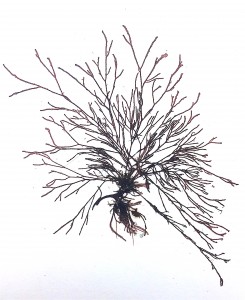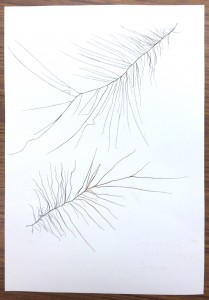In this post, I would like for you to meet some of the algae that are to be placed in the OSU herbarium that I collected and processed into specimens from shorelines close to Eagle Hill Field Station in Maine, July 2016 (see below).
During part of the class, students were introduced to the ethnobotany of algae, i.e., human uses for seaweeds. Brown algae usually contain a polysaccharide, algin, in their cell walls. Algin is used in industry, food and pharmaceuticals to thicken and stabilize products. Examples of products that contain algin include ice cream, yogurt, soups and sauces, medicine tablets and antacids, toothpaste, lotion, lipstick and paint.
Below is some ethnobotanical information that I learned about the species of algae in the slideshow above.
Nori is an edible seaweed that dries to paper-thin sheets. It is often used as a wrap in sushi. In Maine, nori is currently harvested from wild-grown algae beds, however, nori farming soon will be a reality off the coast of Maine.
Irish moss is a primary source of carrageenan that is used as a thickening agent in toothpaste, foods and drinks, such as ice cream, pudding, and beer. The arrow in the photo points to round cystocarps that produce reproductive spores that will be released into the water when mature.
The winged kelp specimen was attached to a rock on the sea floor about four feet below water level at low tide. Winged kelp is edible and it is used in salad, soups and miso. It has a nutty flavor and is high in vitamins.
Dulse is added to salads, sandwiches and soups, and it is also eaten as chips. It is high in vitamins, minerals and amino acids.
Bladder wrack (don’t you just love the name) grows in extensive mats covering the tops of rocks above the low tide line. It is added to soups, applied medicinally to prevent skin irritations, used as a sunscreen, or utilized as a fertilizer. Like many edible seaweeds, it is high in minerals and vitamins. The paired bladders found at the ends of the branches (arrow on the bladder wrack photo) contain a gel with reproductive spores inside. The brown coloring around the bladders (see above) is algin that leached out of the bladders into the surrounding paper.
To make the herbarium specimens shown above, the seaweeds were processed and pressed in the lab after collecting. Preparing seaweeds for pressing is more elaborate than for land plants and often can be an artistic process requiring time and patience.
Since seaweeds are thin and fragile, they often break apart and/or stick together when removed from the water. Therefore, seaweeds are “floated” onto herbarium paper before pressing so that they can be arranged as close to their natural state as possible.
“Floating” is accomplished by placing a herbarium sheet under the water (water from the sea) with the seaweed floating on the water surface. The paper is carefully lifted up while the water slowly drains off the paper leaving behind the algae in a relatively natural position on the paper. However, slowly draining the water may not sufficiently separate smaller branches of the seaweed. In this case, the branches need to be painstakingly teased apart with a blunt probe while a thin film of water is still present on top of the paper.
Below, meet two additional species of seaweeds that I collected that are finely branched, and that required significant time and an artistic flare to arrange and separate tiny branches.
As of yet, the red alga on the left is unidentified, but I know it is polysiphoneous which means it has a central core of cells surrounded by a cortex. The branches appear jointed because the cells of the core and cortex are the same length, beginning and ending at the same place. This species also has tiny spines at each joint.
Each side branch of the brown alga on the right was carefully separated from the main branch using a blunt probe to gently nudge the branches into position as the plants were “floated” onto herbarium paper before drying.
After pressing and drying, some seaweeds need to be glued onto the paper and some, especially brown algae that contain algin, often adhere to the herbarium paper without glue. Some algae, such as the finely branched red algae, make exquisitely beautiful specimens.
Meet a couple more unique and beautiful brown and red algae species collected in Maine near Eagle Hill Field Station (below). Note the brown shadow around the sausage weed specimen. The shadow is formed from algin that diffused from the alga into the surrounding paper.
In closing, I will leave you with a fun fact about sausage weed. The name sausage weed comes from the branches that have sausage-like constrictions. Trivia time, here we come!
About the Author: Dr. Cynthia Dassler is curator of Cryptogams (small plants that produce spores) at The Ohio State Herbarium (OS) in the Department of Evolution, Ecology and Organismal Biology.
Photos by Cynthia Dassler.



